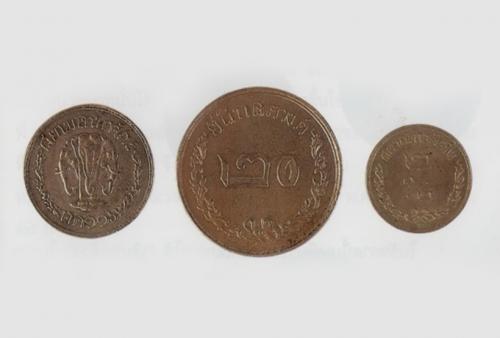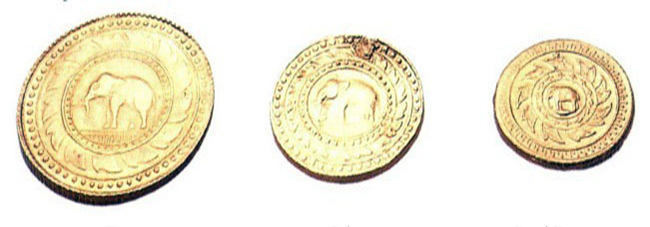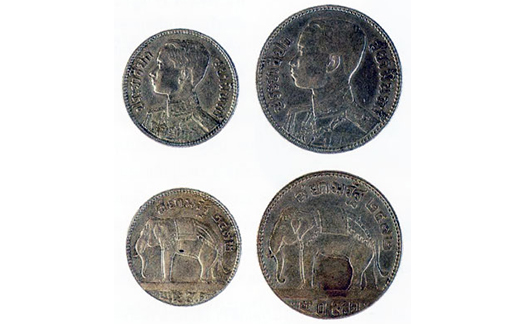| 4 Pai |
amounts to |
1 Fuang |
| 2 Fuang |
amounts to |
1 Salung |
| 4 Salung |
amounts to |
1 Baht |
| 4 Baht |
amounts to |
1 Tamlung |
| 20 Tamlung |
amounts to |
1 Chang |
Currency and currency units in Ayutthaya period continued to be in use until the period of Thonburi and early Rattanakosin. Later on, in the reign of King Rama IV, there was a dramatic growth of commerce between Thailand and other foreign countries. A greater number of foreign merchants came to the country to do trade. They exchanged their currency for Pod Duang from Thai authority so that they could buy goods from common people. However, Pod duang was being produced solely by the royal department of silversmith and there was no machinery used in the production. There were ten kilns that were used to produce Pod Duang. By estimation, one kiln could produce 240 Baht’s worth of Pod Duang. In one day, Thai authority could produce around 2,400 baht’s worth of Pod Duang. Hence, there were not enough Pod Duang to be exchanged. This caused inconveniences and resulted in losses of the country's commerce. Therefore, King Rama IX proposed the change of Thai currency, to substitute Pod Duang with coins which were made by machines.

(left): Sio, (right):Sik
(left):Att, (right):Solos
In 1857, King Rama IV sent a diplomatic corps to England in order to cultivate a friendly relation with Queen Victoria. When the queen had learned about the need of machinery for coin making, she sent in a small-sized coin making machine as a royal gift. Thus, King Rama IV commissioned that coins be made for the first time. These coins were called, "Rien Bannakarn” (Royal Gift Coins). Meanwhile, the diplomatic corps also ordered coin making machines from Taylor Company in 1858. King Rama IV then commissioned that the Royal Thai Mint be built in front of the Royal Treasury in the palace and gave to it the name "Sittikarn Mint". Then, in 1862, the king commanded the mint to produce tin coins in another two denominations, namely At and Solos, to be used in substitution to seashell Bia. Also, he ordered the production of gold coins to be used as a currency. They were produced in three denominations, namely Tos, Pis, and Pad Dungs. Later there was also a production of round flat coins to be used as a medium of exchange throughout the reign of King Rama IV. During this reign, the same currency standard was still in use. It may be summarized as follows:
| 50 Bia |
amounts to |
1 Solos |
| 2 Solos |
amounts to |
1 Att |
| 2 Att |
amounts to |
1 Siao (or Pai) |
| 2 Siao |
amounts to |
1 Sik |
| 2 Sik |
amounts to |
1 Fuang |
| 2 Fuang |
amounts to |
1 Salung |
| 4 Salung |
amounts to |
1 Baht |
| 10 Salung |
amounts to |
1 Pad Dungs |
| 4 Baht |
amounts to |
1 Tamlung |
| 4 Baht |
amounts to |
1 Pis |
| 8 Baht |
amounts to |
1 Tos |
| 20 Tamlung |
amounts to |
1 Chang |
(Lift): Tos, (central): Pis, (right): Pad Dungs
Later in the reign of King Rama V, Thai economic system expanded a lot further. Prince Mahisornratchaharuthai, Minister of Finance at the time, saw that there were too many denominations in Thai currency which were causing inconvenience for calculations and book keeping. Originally, in book keeping there were columns for Chang, Baht, Att. However, the amount of a hundred and a thousand will be counted when the amount exceeds a thousand Chang. This often caused the account to be crossed up, hence caused further inconvenience. Therefore, in 1897, the Prince Minister wished to change the denominations to Baht and Satang, hoping to simplify the calculation process for smaller units by adopting decimal system. It was assigned that 100 Satangs amounts to 1 Baht.
The word 'Satang' means per hundred. The term was already commonly used in Mathematics. It refers to an amount which divides one to several equal parts. There exists an explanation in a royal document written by King Rama IV which says:
| 1/10 |
is called |
Tossang |
| 1/100 |
is called |
Satang |
| 1/1,000 |
is called |
Sahassang |
| 1/10,000 |
is called |
Nahuttung |
| 1/100,000 |
is called |
Lakkang |
| 1/1,000,000 |
is called |
Tossa Lukkang |
| 1/Kodt |
is called |
Go Tang |
Then, Prince Mahisornratchaharuthai ordered Satang coins made of nickel from overseas for the first time in 1898. They were coins with no hole in the center. The first public announcement regarding the circulation of nikle Satang was announced on 21 August 1898. According to the announcement, King Rama V commissioned the production of four types of Satang coins made of nickel. All four types of coins have an image of a three-headed elephant on one side, and were engraved with the letters which reads "Royal Kingdom of Siam Year 116". Meanwhile, each type of coins was different on another side. The differences could be characterized as follows:
Type 1 was engraved with the letters which says "twenty Satang". There is number of 20 written in big size in the centre. It has a value of 20 Satang. 5 coins amount to 1 baht.
Type 2 was engraved with the letters which says "ten Satang". There is number of 10 written in big size in the centre. It has a value of 10 Satang. 10 coins amount to 1 baht.
Type 3 was engraved with the letters which says "five Satang". There is number of 5 written in big size in the centre. It has a value of 5 Satang. 20 coins amount to 1 baht.
Type 4 was engraved with the letters which says "two and a half Satang". There is number of 2 1/2 written in big size in the centre. It has a value of 20 Satang. 40 coins amount to 1 baht.
Not only did this announcement speak of the production of Satang coins, it also proposed that, henceforth, in book keeping one must use only two columns which accommodate the units of Baht and Satang. Satangs equals to 1/100 of Baht. This is to reduce the amount of numbers and to simplify calculation process. There would be no need to reduce or break up numbers. It would be more simply and faster to calculate than with the original scale system. It was also mentioned in this announcement that citizens were to use these nikle Satang coins to exchange since 21 September 1898 onwards. However, Satang coins were in circulation along with Siao, Att, and Solos, copper coins which had been announced to be used earlier. Thus there emerged a problem about the exchange between Satang and Att. Because 1 Baht equals to 100 Satangs and also equals to 64 Att, the conversion between Att and Satang thus became aliquant. Luang Wichitwathakan made a statement regarding the problem at the early stage of adjusting currency system as below:
"I was born and grew up right in time when Satang was introduced throughout the Kingdom. And I heard the people raise grievances over this issue because it was being used along with the old Att. Users who were used to the old Att always had to convert [Satang] to the old Att. Commodity price and trading were still spoken of in the old manner, i.e. using Fuang, Salung. It was easy in the case of Salung because 25 Satangs equals exactly to 1 Salung. In the case of Fuang, on the other hand, there came a problem. Receiver wanted 13 Satangs while payer would pay 12 Satangs. The government designated that 3 Satangs amounts to 1 Pai (i.e. 2 Att). The problem was, if a price of a merchandise is 1 Att, how many Satangs does it cost? There existed a difficulty of this sort for a period of time until people became used to Satangs and stopped speaking in terms of Fuang and Att all together and only referred to this or that amount of Satangs."
In 1908 King Rama V commissioned Prince Chantaburinarunah, Minister of Finance at the time to issue banknotes in the denomination of one baht. The king also ordered that an adjustment be made regarding banknotes and coins. Also, there was a production of coins. Fuang and copper coins as well as nickel Satang were announced obsolete. Salung coins were also put out of circulation. New kind of Salung and two Salung money were put to use. The problem of converting Satang and Att thus improved.
Although, decimal system has been adopted for currency conversion, in the reign of King Rama VI, high-cost coins made of silver, including Baht, two-Salung and one-Salung, were still in production as had been in the previous system. This was because people were still used to using them. As for coins in Satang unit, which were less valuable denomination, they were made of copper and nikle. During the reign of King Rama VI, the King commissioned a production of new set of mint coins for circulation. After the succession to the throne, it was an appropriate time to initiate a new standard of currency units based solely on decimal system. There were productions of mint coins in Satang unit, namely 25 and 50 Satang coins. In the reign of King Rama VIII, there were productions of mint in the denomination of 1/2 Satang, 1 Satang, 5 Satang, 10 Satang, 20 Satang, 25 Satang and 50 Satang for circulation.

Coins
(left): 25 Satangs (right): 50 Satangs
During the reign of the current king, coins have been produced according to 9 denominations, namely, 1 Satang, 5 Satang, 10 Satang, 25 Satang, 50 Satang, 1 Baht, 2 Baht, 5 Baht, 10 Baht. The denominations of 25 Satang, 50 Satang, 1 Baht, 2 Baht, 5 Baht, 10 Baht are in circulation whereas 1 Satang, 5 Satang and 10 Satang are being used only in banking system.
It can very well be observed that Suwannaphum has been prosperous since ancient time, especially in commerce. People here have been trading goods since old times. In the early stage, the trade was carried according to direct barter system. Then, money was introduced to be used as medium of exchange. Not until Sukhothai period was Pod Duang money invented. It designates value of money corresponding to weight. Apart from Pod Duang, There was evidence of Bia also being used as a smaller denomination. These two currency units had been used as medium of exchange in Thai economic system for a very long time up until Rattanakosin period. In the reign of King Rama IV, the economy of the country was prospering and international trade was thriving, so much so that it caused a shortage of Pod Duang. Pod Duang in circulation was not enough to accommodate the need of merchants, both Thai and foreign. Thus, the king commissioned a Royal Mint in order to produce coins to be used as a substitution for Pod Duang. However, the standard of currency remained the same.
Later during the reign of King Rama V, there was a change which is very significant to Thai currency system, namely the change of currency standard from weight system decimal system. It was assigned that 100 Satang amounts to 1 Baht. This can be called a reform of Thai Financial system in order to meet with international standards. Also, it has rendered book keeping more convenient. This process of adjustment took place from the reign of King Rama V to the reign of King Rama VII, when decimalization reached its full achievement. As a result, this currency according to decimal system has been in use until today.
Translated from
Sarawut Watcharapuntee. (2013). Thai Currency Standard.Retrieved June 17, 2013, from Pavilion of Regalia, Royal Decorations and Coins e-museum: http://emuseum.treasury.go.th/ (Thai language)





